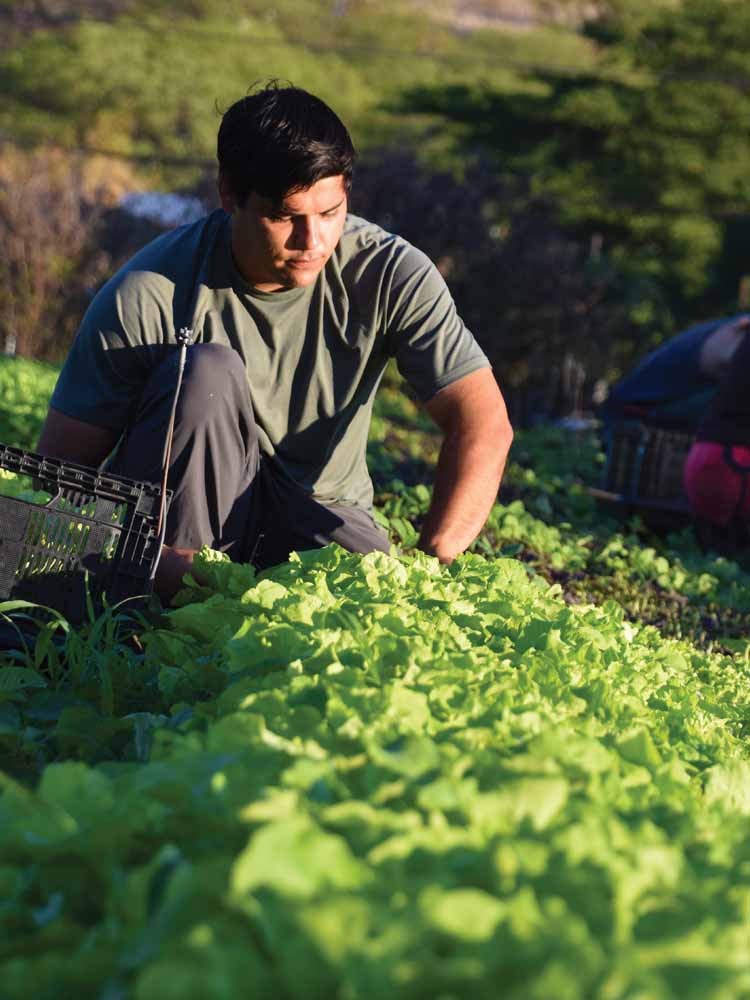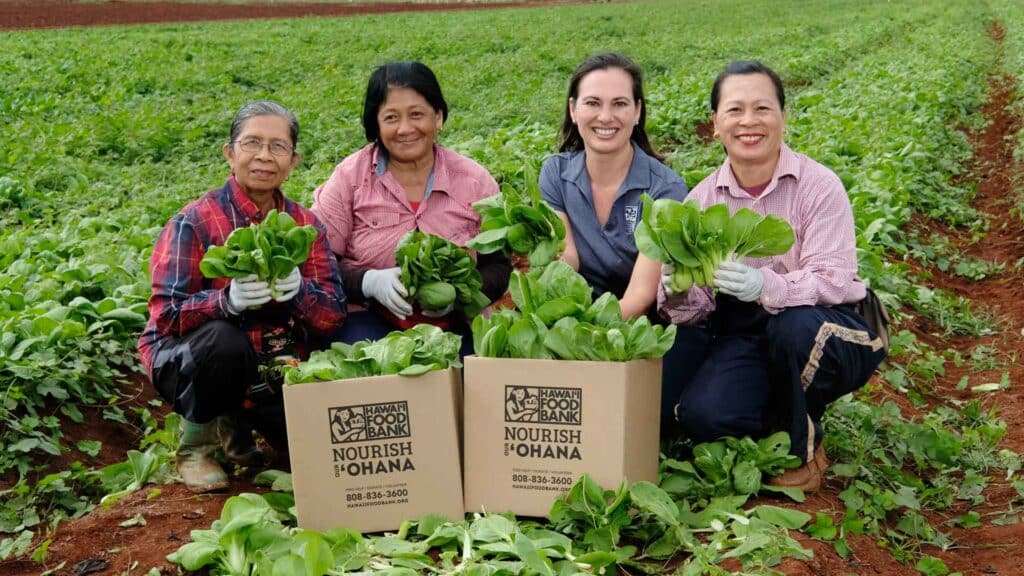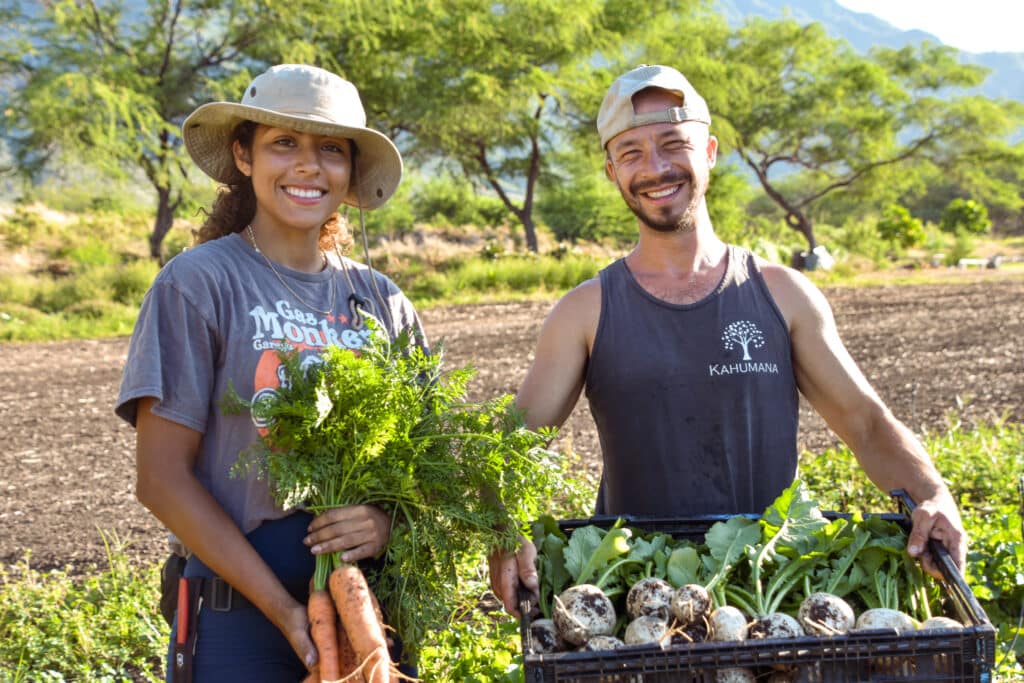Our Work
Farm to Families
Hawai‘i Foodbank's Farm to Families program provides fresh, healthy food to those in need while also supporting local farmers and producers.
The Farm to Families program is one of Hawai‘i Foodbank’s signature programs. Through Farm to Families, we are able to support our local food systems while, at the same time, providing fresh, healthy, Hawai‘i-grown food to those in our community facing hunger. Since the program’s inception in 2020, we have invested nearly $12.2 million in more than 40 farms and food hubs and distributed over 9.7 million pounds of local produce and proteins — including culturally important foods such as poi, ‘uala and ‘ulu, to our community.
Updated April 1, 2025

A Win-Win for Our Community
Food insecurity is a critical issue in Hawai‘i, where 1 in 3 households, including more than 90,000 keiki, lacks comprehensive access to healthy, nutritious food. Hawai‘i has the highest cost of living in the nation, and inflation has driven food prices up by more than 25% compared to before the pandemic. As a result, far too many families are at risk of going hungry or must make impossible choices between food and rent, food and medicine, or food and transportation.
The Farm to Families program addresses these critical needs while investing in our local food systems at the same time. Every dollar in the Farm to Families program does double duty — allowing us to not only provide fresh, local produce and proteins to those we serve but also invest in local agriculture. This, in turn, provides a myriad of additional benefits: supporting our local farmers, helping to buoy our local economy and food system, and decreasing our dependence on imported food.
The Healthy Choice
Hunger and health are deeply connected. Food insecurity can lead to negative health outcomes such as Type 2 diabetes, high blood pressure and heart disease. We know that for many families, as budgets grow tighter, households tend to shift towards cheaper food options, which can be highly processed with reduced nutritional value as compared to more expensive whole foods. At Hawai‘i Foodbank, we believe that equitable access to safe and healthy food is a fundamental human right, and are committed to providing healthy options for our community. Last year, over 25% of all food distributed by Hawai‘i Foodbank was fresh produce, and nearly half of that was grown locally.
Food Rescue and Composting
While programs like Farm to Families allow us to purchase foods direct from farmers and food hubs, food rescue is also an important part of our business model. We work with retailers, distributors, wholesalers, and community members to donate excess food that might otherwise be thrown away. Each year, Hawaii Foodbank rescues more than 10 million pounds of good food from going to waste, and distributes it to those facing hunger in our community.
Food safety is of paramount importance to us, and we inspect donated food items at our warehouse to ensure they are safe to eat. Inevitably, some food cannot be rescued, and we divert as much as possible to our composting partners — Full Circle Farm and Kahumanu Organic Farms — and pig farmers to keep as much food as possible out of the waste stream.
“To establish a local food distribution system as part of making a more food secure Hawaiʻi, Hawaiʻi Foodbank has been a big part of this for us. There’s been no other organization that has supported us this much. It’s been absolutely game-changing. It’s allowed us to achieve a lot of the goals towards sustainability that we’ve wanted for a long time. There have been many, many benefits that have happened in local farming, and the food and agricultural community is better because of Hawaiʻi Foodbank’s involvement.”
— Kahumana Farms
History of Farm to Families
Originally termed Farm to Foodbank, Hawai‘i Foodbank established theFarm to Families program during the pandemic through a strategic partnership with the Hawai‘i Farm Bureau, with a commitment to purchase locally produced foods from local farmers and ranchers when their regular markets shut down. We recognized the importance of keeping Hawai‘i’s farmers farming, and the partnership provided a new way to get high-quality, nutritious food to some of Hawai‘i’s most vulnerable communities. This investment helped many farmers sustain operations during the pandemic and offset losses from the shuttered tourism industry while helping meet the unprecedented need for food for those who suddenly found themselves unemployed.
Farm to Families: Kahumana Farms
Farm to Families: Huang’s Green Leaf Products
Funding
At first, the Farm to Families program was primarily funded through COVID-era pandemic relief funds. Since those funds have lapsed, we have continued to fund our Farm to Families program through private philanthropic support and other sources. You can help support both local farmers and fight hunger, too, by making a donation:

About Hawai‘i Foodbank

Hawai‘i Foodbank is Hawai‘i’s largest hunger relief organization, fiercely dedicated to our mission of nourishing our ‘ohana today while working to end hunger tomorrow. We work with a network of more than 200 partner agencies across O‘ahu and Kaua‘i to provide food assistance to an average of more than 150,000 people each month. Last year, we distributed food for more than 14.7 million meals across the islands we directly serve, including 5 million pounds of fresh produce. Together with the Maui Food Bank, serving Maui County, and The Food Basket, serving Hawai‘i Island, our network of food banks and partner agencies provide food assistance to all those facing hunger across the State.
Nationwide Support and Accountability
Hawai‘i Foodbank is a certified member of Feeding America – the nation’s largest hunger-relief organization, encompassing a network of 200 food banks across the United States. Certification means Hawai‘i Foodbank is held to the highest standards for food handling, storage and distribution, financial management, organizational stability, board governance, and more.



